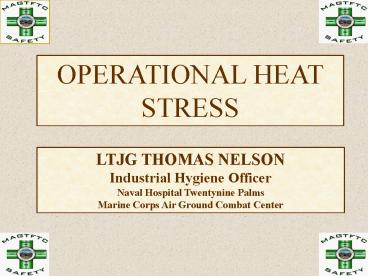Heat Precautions - PowerPoint PPT Presentation
1 / 18
Title: Heat Precautions
1
OPERATIONAL HEAT STRESS
LTJG THOMAS NELSON Industrial Hygiene
Officer Naval Hospital Twentynine Palms Marine
Corps Air Ground Combat Center
2
- OVERVIEW
- HEAT DISORDERS
- SYMPTOMS
- WARNING SIGNS
- TREATMENT
- LOCAL CONDITIONS AND ORDERS
- SUMMARY
3
HOW TO RECOGNIZE TREAT ...
HEAT STROKE OR HEAT EXHAUSTION
4
Heat Cramps This normally happens after
exercise. Most often to people who arent used
to the heat, who sweat a lot or dont drink
enough fluids.
Symptoms Severe pain and cramps in legs and
abdomen, fainting or dizziness, weakness, profuse
sweating and headaches.
5
TREATMENT Increase fluid intake, increase salt
intake, rest and move to a cool place.
6
Heat Exhaustion This is caused by the loss of
body fluids and important salts due to
overexposure to high temperatures and humidity.
Usually you are exposed to heat for a prolonged
amount of time and you become dehydrated.
Symptoms Headache, nausea, fatigue, dizziness,
skin is cool and pale, pupils become dilated.
Victim is usually conscious but may faint, has a
core temperature of over 102.
7
- Heat Exhaustion starts with the accumulation of
large quantities of blood in the skin in the
bodys attempt to increase its cooling
efficiency. - This is normally due to temperature conditions
the individual is not used to. - There is a loss of circulating blood volume in
the body which decreases the blood supply to the
brain, increasing the likelihood of fainting.
8
TREATMENT Get to the shade, cool off, increase
fluids, cold wet towels or ice, fan, elevate legs
above heart, loosen clothing, dont give any
liquids containing alcohol or caffeine, may need
IV. If condition worsens seek medical attention
immediately. If left untreated Heat Exhaustion
can lead to HEATSTROKE.
9
Heat Stroke Is a medical emergency and a life
threatening condition. It is caused by the
failure of the heat-regulating mechanisms of the
body, due to high heat and humidity.
Symptoms Headache, nausea, dizziness, skin is
red, dry and very hot (sweating has ceased).
Pulse is strong and rapid, small pupils, high
fever 105. May be disorientated, lose
consciousness, possible convulsions.
10
- The underlying cause of heat stroke is
connected to the sudden inability to dissipate
body heat through perspiration. - This accounts for the excessive rise in body
temperature and its the high fever which can
cause permanent damage to internal organs, and
can lead to death.
11
- When someone passes out from heat stroke, his
or her brain is being cooked just as the
colorless part of an egg turns white when it hits
the griddle. - Any cold liquid should be used to cool the
victim. - Once revived, the victim should be watched for
more than an hour as his temperature can start to
rise to high levels again.
12
TREATMENT Remove to cooler location, loosen
clothing, immerse in cool water, wrap in wet
sheets, cold compresses to the head, neck and
groin. SEEK MEDICAL ATTENTION IMMEDIATELY. DO
NOT give medication to lower fever, DO NOT use an
alcohol rub.
13
GENERAL PRECAUTIONS
14
- Every year people pass out and some even die
during exercise from heat stroke. But you do get
plenty of warning. - First your muscles are affected, as your
temperature rises they feel like a hot poker is
pressing against them. - As your temperature rises further, the air you
breathe feels like it is coming from a furnace
and no matter how hard you try, you cant get
enough air. STOP EXERCISING. Take a break and
drink fluids.
15
- If you continue, your body temperature will
rise further and affect your brain. - Your head will start to hurt, you will hear
ringing in your ears, you will feel dizzy and may
have difficulty seeing, and the next step is
unconscious on the ground. - Know your limits, recognize your physiological
response, and drink plenty of fluids prior to and
during training evolutions.
16
- CCO 6200.3D covers MCAGCC Heat Warning Flag
Conditions - Naval Hospital manages system and posts
conditions on the Internet - Unit Safety Functions monitor web-site for
changes - BearMat Notifies Units of drastic changes
- If system goes down, phone calls are made
periodically, or as conditions change
17
- Operational units should add 10 degrees to the
listed WBGT, due to wear of Tactical Gear - This denotes extra care and vigilance to
recognize symptoms and warning signs - Planning is key
- Unit Safety/Logistics Plays and Integral Role
- Heat Stress Victims are extra sensitive to
further episodes due to physiological changes
that occur resultant to heat strain. - Can limit operational effectiveness to a degree
- Application of ORM Principles is key
18
QUESTIONS?































